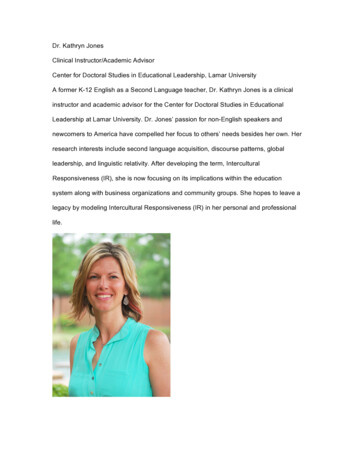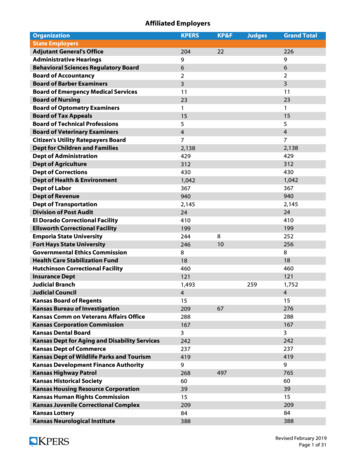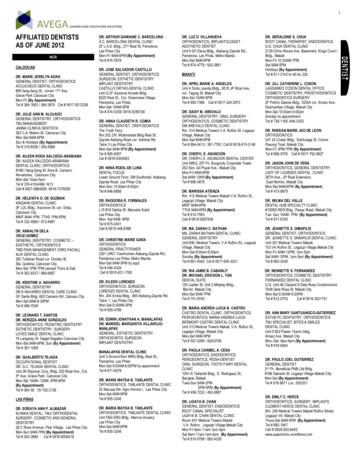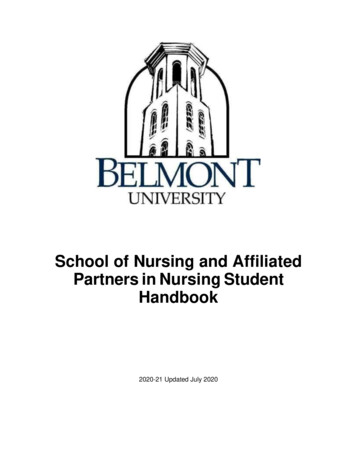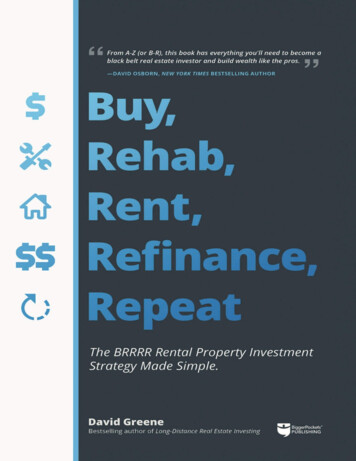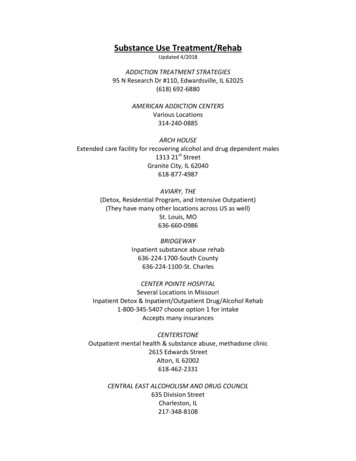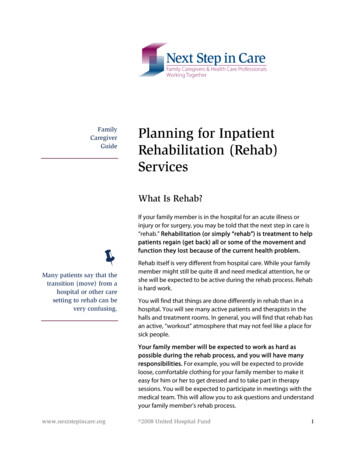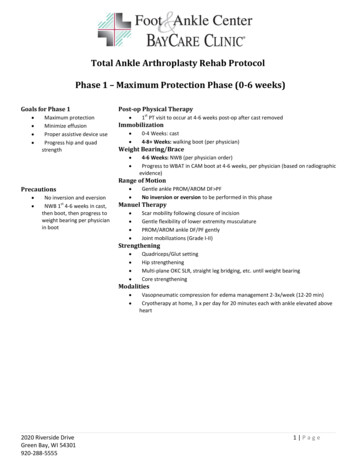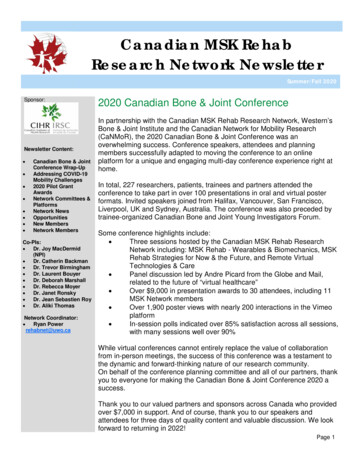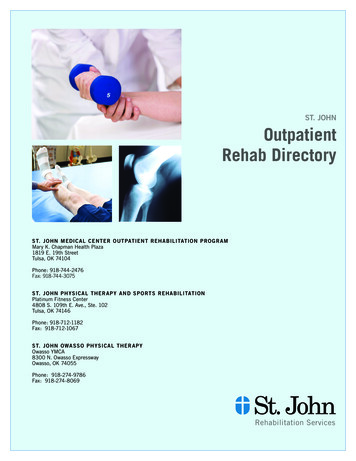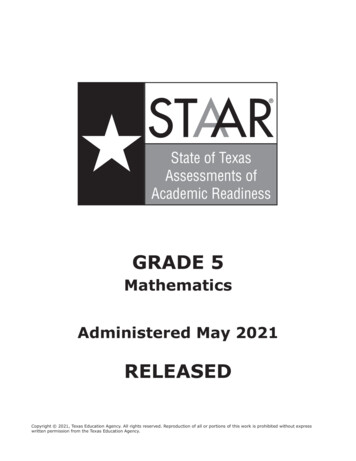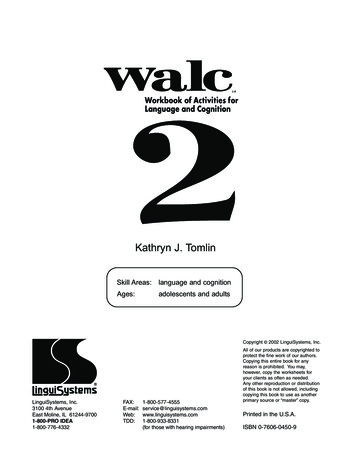
Transcription
Kathryn J. TomlinSkill Areas: language and cognitionAges:adolescents and adultsCopyright 2002 LinguiSystems, Inc.LinguiSystems, Inc.3100 4th AvenueEast Moline, IL 61244-97001-800-PRO 00-933-8331(for those with hearing impairments)All of our products are copyrighted toprotect the fine work of our authors.Copying this entire book for anyreason is prohibited. You may,however, copy the worksheets foryour clients as often as needed.Any other reproduction or distributionof this book is not allowed, includingcopying this book to use as anotherprimary source or “master” copy.Printed in the U.S.A.ISBN 0-7606-0450-9
About the AuthorKathryn J. Tomlin, M.S., CCC-SLP, has been working withindividuals with language and cognitive impairments since1980. The exercises and techniques in this book haveevolved through her experiences. She has worked as aspeech-language pathologist in various settings. In additionto working and writing, Kathy is actively involved in missionswork around the world.Kathy is a longtime author with LinguiSystems as WALC 2was originally published in 1984. Kathy is also the author ofWALC 1, WALC 3, ACE 1, ACE 2, The Source for MemoryExercises, and The Source for Apraxia Therapy. She hasalso co-authored The Source for Group Language Therapyand two chapters in the book Minor Head Trauma, SpringerVerlag, New York: 1993.AcknowledgmentDeep appreciation to all of the co-workers, friends, and clients who have usedWALC 2 and have provided me with many helpful suggestions during this book’sdevelopment and growth stagesDedicationTo Howard and Jayne Tomlin in appreciation for their guidance in all my endeavors.Author Photo by Wendy MoorePage Layout by Jamie Hope
ForewordMany years ago, when I began working with people with head injuries andneurological impairments, I was faced with the challenge of developing therapeuticmaterials for many areas and levels of language and cognitive retraining. As a resultWALC 2 (Workbook of Activities for Language and Cognition) emerged.WALC 2 has gone through an evolution of improvement by way of client and fellowspeech-language pathologists who provided practical, “hands-on” suggestions. You’llfind that WALC 2 is an excellent therapy supplement for trained professionals, clients’families, and clients.However you use WALC 2, it is my sincere hope that all will benefit from using theexercises.Kathy
Table of ContentsForeword .3Introduction .9Unit 1: Attention and Concentration .11Addition .12Subtraction .15Multiplication .18Division .21Mixed Math Problems .24Search Out Words .27Crossword Puzzles .40Seek Out Words .48Visual Scanning .53Unit 2: Memory for General Information .63General Information Questions .64General Information Questions: Multiple Answers .71General Information Questions: Objects .73General Information Questions: Occupations .74General Information: Animals .75General Information: Food and Drink .76General Information: The United States .77General Information: Places .78General Information: People .79General Information: Important Days .80
Yes/No Questions: General .81Yes/No Questions: Comparisons .84Yes/No Questions: Quantity .85Unit 3: Visual and Auditory Memory .87Paired Words: Associated.88Chaining Word Lists: Associated .90Chaining Word Lists: Varied .91Following Written/Oral Directions (1 step - 2 components) .92Following Written/Oral Directions (2 steps - 4 components) .94Following Written/Oral Directions (3 steps - 6 components) .96Following Written/Oral Directions: Drawing Figures .97Word List Retention: Category Inclusion .99Word List Retention: Category Exclusion .100Word List Retention: Word Placement .101Word List Retention: Recall by Attribute .103Functional Memory: Memo .104Functional Memory: Appointments .105Functional Memory: Directions .106Functional Memory: Paragraph Facts.107Mental Manipulation: Opposites with a Delay.109Mental Manipulation: Math .110Mental Manipulation: Reverse Order.111Mental Manipulation: Scrambled Sentences.112Mental Manipulation: Word Progression .113Mental Manipulation: Alphabetical Order .114Mental Manipulation: Ranking.115Mental Manipulation: Largest Number .116Remembering Sentences .117Retention of a Paragraph .120
Unit 4: Sequential Thought .143Fill in the Letters .144Sentence Completions .149Story Completions .154Scrambled Words .156Scrambled Sentences .160Sequencing the Steps .171Unit 5: Reasoning .181Category Members — Concrete .182Category Members — Abstract .185Add to the Category — Concrete .187Add to the Category — Abstract .189State the Category — Concrete .191State the Category — Abstract .193Wrong Category — Concrete .194Wrong Category — Abstract .197Stating Logical Conclusions .198Problem Solving — Answering Questions .202Similarities and Differences .203Object Description .207Opposites .208Definitions .212Multiple Definitions .215Describing with Attributes .220Inconsistencies in Sentences .222Constant Characteristics .226Analogies .228Word Deduction .233Proverbs and Expressions .238Written Directions .243Multiple Sentence Formulation .249
Multiple Uses for Objects .251Stating Situational Problems .252Improving a Product or Event .254Improving an Institution or Situation .256Determining Consequences of Changes .257Stating an Item with an Imagined Improvement .259Positive and Negative Viewpoints .261Multiple Character Viewpoints .263Inferences About Paragraphs .267Deduction Puzzle #1 .273Deduction Puzzle #2 .274Deduction Puzzle #3 .275Deduction Puzzle #4 .276Deduction Puzzle #5 .277Deduction Puzzle #6 .278Answer Key .279
IntroductionWALC 2 was developed to provide stimulus materials to aid in the remediationof language and cognitive disorders in adolescents and adults. The items in thisworkbook provide a structured approach for improving specific skills in target areas,although adaptations may be necessary to meet each client’s needs. All exerciseswithin this workbook remediate a specific deficit, but also require skills in other areasof language and cognition in order to be completed appropriately.Unit 1: Attention and ConcentrationThis first unit of WALC 2 focuses on attention and concentration. Frequently,patients with neurological impairments exhibit difficulty in attending to orcompleting structured therapy tasks. These exercises enable the client tocomplete the tasks with minimal challenges to his cognitive abilities.Unit 2: Memory for General InformationThis unit requires the use of remote memory skills in order to answer questions.Since the general information questions elicit information from patients withvarious backgrounds, be aware of errors which occur as a result of a languageor cognitive deficit versus responses which occur due to lack of familiarity withthe targeted information or due to cultural factors. Require the client to expandhis responses, if appropriate, realizing that retrieval skills for words andinformation and comprehension of information and questions are necessaryto respond accurately to these questions.Unit 3: Visual and Auditory MemoryThe activities of the third unit focus on the client’s visual and auditorymemory. These exercises do not focus on or necessitate normal interactivecommunication, but should be regarded as teaching strategies for memory.Strategies such as “chunking” and visual imagery lend themselves to individualWALC 29Copyright 2002 LinguiSystems, Inc.
practice and drill rather than to turn-taking and pragmatic interaction. So, beaware that these exercises should not be used exclusively to retrain memory,but should be incorporated with exercises that put memory to use in context.Unit 4: Sequential ThoughtThis unit emphasizes the reorganization and retraining of cognitive skills bysequential thought retraining.Unit 5: ReasoningThe focus of this unit is to facilitate the ability to organize information, solveproblems, reason, and develop interpersonal insights. The exercises have beensequenced in a hierarchical order so that a client begins to retrain thinking at aconcrete level and progresses to an abstract reasoning level.In summary, WALC 2 provides you with practical therapeutic materials for use indeveloping comprehensive individual intervention programs. Sharing these exerciseswith clients’ families helps to establish the importance of improving communicationoutside the therapy setting.KathyWALC 210Copyright 2002 LinguiSystems, Inc.
Unit 1Attention and ConcentrationWALC 211Copyright 2002 LinguiSystems, Inc.
AdditionSolve these problems.Unit 1: Attention and ConcentrationWALC 212Copyright 2002 LinguiSystems, Inc.
AdditionSolve these problems.Unit 1: Attention and ConcentrationWALC 213Copyright 2002 LinguiSystems, Inc.
AdditionSolve these problems.Unit 1: Attention and ConcentrationWALC 214Copyright 2002 LinguiSystems, Inc.
SubtractionSolve these problems.Unit 1: Attention and ConcentrationWALC 215Copyright 2002 LinguiSystems, Inc.
SubtractionSolve these problems.Unit 1: Attention and ConcentrationWALC 216Copyright 2002 LinguiSystems, Inc.
SubtractionSolve these problems.Unit 1: Attention and ConcentrationWALC 217Copyright 2002 LinguiSystems, Inc.
MultiplicationSolve these problems.Unit 1: Attention and ConcentrationWALC 218Copyright 2002 LinguiSystems, Inc.
MultiplicationSolve these problems.Unit 1: Attention and ConcentrationWALC 219Copyright 2002 LinguiSystems, Inc.
MultiplicationSolve these problems.Unit 1: Attention and ConcentrationWALC 220Copyright 2002 LinguiSystems, Inc.
DivisionSolve these problems.Unit 1: Attention and ConcentrationWALC 221Copyright 2002 LinguiSystems, Inc.
DivisionSolve these problems.Unit 1: Attention and ConcentrationWALC 222Copyright 2002 LinguiSystems, Inc.
DivisionSolve these problems.Unit 1: Attention and ConcentrationWALC 223Copyright 2002 LinguiSystems, Inc.
Mixed Math ProblemsSolve these problems.Unit 1: Attention and ConcentrationWALC 224Copyright 2002 LinguiSystems, Inc.
Mixed Math ProblemsSolve these problems.Unit 1: Attention and ConcentrationWALC 225Copyright 2002 LinguiSystems, Inc.
Mixed Math ProblemsSolve these problems.Unit 1: Attention and ConcentrationWALC 226Copyright 2002 LinguiSystems, Inc.
Search Out WordsLocate the names of the fruit in this puzzle.ORANGEAPPLEPEARGRAPEPLUMPEACHLocate the states and other geographical words in this puzzle.TEXASMAINEKANSASIOWAALASKASTATEUSAUnit 1: Attention and ConcentrationWALC 227Copyright 2002 LinguiSystems, Inc.
Search Out WordsLocate the colors in this cate the vegetables in this puzzle.Unit 1: Attention and ConcentrationWALC t 2002 LinguiSystems, Inc.
Search Out WordsLocate the games and sports words in this BOXINGCATCHGOLFTAGTEAMBASEBALLBATSWIMMINGUnit 1: Attention and ConcentrationWALC 229Copyright 2002 LinguiSystems, Inc.
Search Out WordsLocate the fish and fishing words in this ADDOCKMINNOWSTROUTPERCHRODUnit 1: Attention and ConcentrationWALC 230Copyright 2002 LinguiSystems, Inc.
Search Out WordsLocate the things you drink and other related words in this RSTYGLASSCUPICESIPUnit 1: Attention and ConcentrationWALC 231Copyright 2002 LinguiSystems, Inc.
Search Out WordsLocate the animals in this ANTCOWDEERBIRDHORSETIGERPENGUINRABBITWOLFUnit 1: Attention and ConcentrationWALC 232Copyright 2002 LinguiSystems, Inc.
Search Out WordsLocate the measurement words in this INTYARDHOURMINUTEMILEYEARFOOTSECONDDAYUnit 1: Attention and ConcentrationWALC 233Copyright 2002 LinguiSystems, Inc.
Search Out WordsLocate the cities in this puzzle.BOISEBOULDERRENOORLANDOATLANTASANTA FEAUSTINDALLASJUNEAUEASTONBOSTONDULLESUnit 1: Attention and ConcentrationWALC 234Copyright 2002 LinguiSystems, Inc.
Search Out WordsLocate the hospital words in this LDINGPILLSBEDORDERSBLOODAIDESDIETFLOORUnit 1: Attention and ConcentrationWALC 235Copyright 2002 LinguiSystems, Inc.
Search Out WordsLocate the words of emotion in this DBOREDFAIRWEARYFEARWELLWILDFULLHUNGRYTHIRSTYUnit 1: Attention and ConcentrationWALC 236Copyright 2002 LinguiSystems, Inc.
Search Out WordsLocate the states in this puzzle.ALABAMACALIFORNIAIOWATENNESSEEN
Kathryn J. Tomlin, M.S., CCC-SLP, has been working with individuals with language and cognitive impairments since 1980. The exercises and techniques in this
